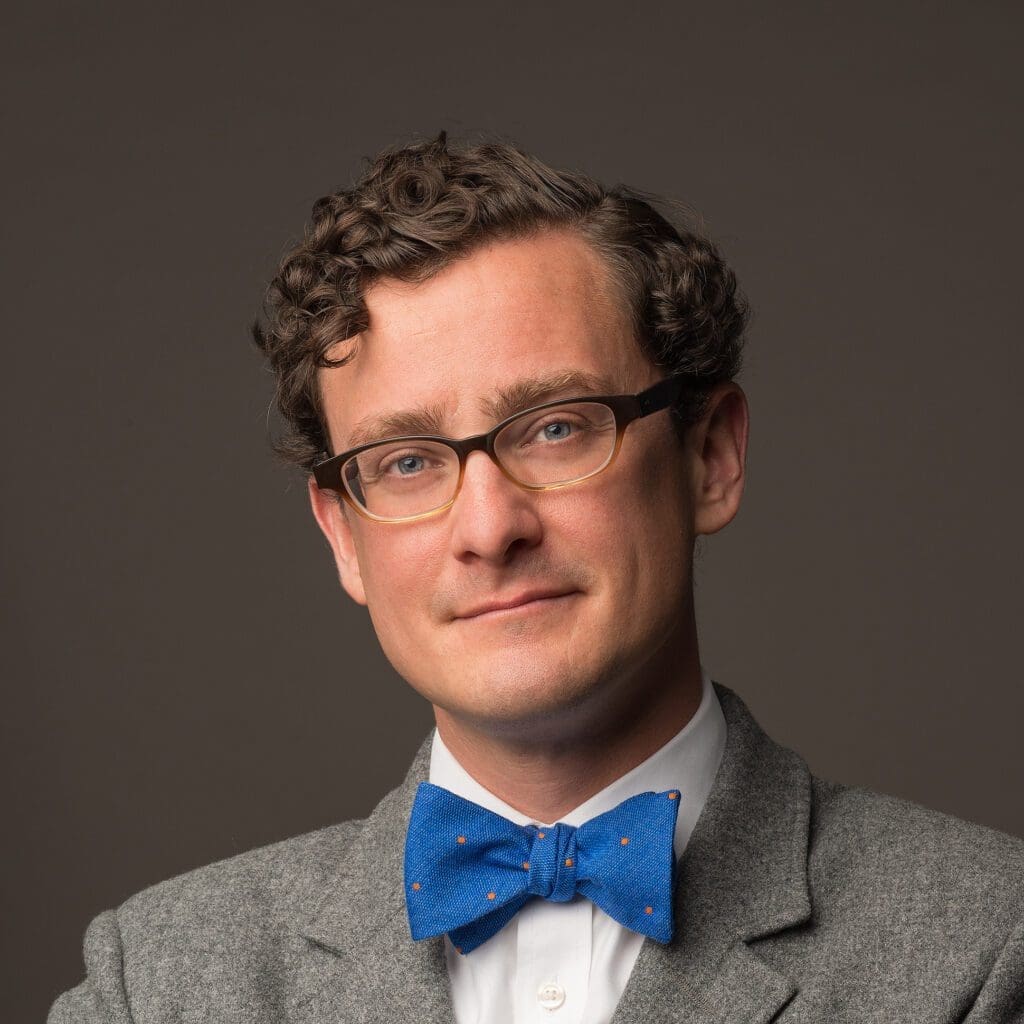B
Taking Jesus’ historical humanity seriously . . . obliges us to take Mary seriously. . . . This is the orthodox faith; and it finds its lifeblood in the mystery summed up in Mary’s yes, in her love-in-darkness. Orthodoxy’s lifeblood is here, just as—literally—Christ’s lifeblood begins here.
—Rowan Williams, “The Seal of Orthodoxy: Mary and the Heart of Christian Doctrine”
Because the Jewish Mary, while being fully herself, nevertheless represents the church, there are enough Marys in the world to represent every ethnicity. We have seen how the Huron-Wendat certainly found their mother, Our Lady of Loreto, to be a considerable improvement on the frequently vindictive goddess Aataentsic. The Huron-Wendat had so identified with Mary in their settlement of L’Ancienne Lorette and its Holy House outside Québec City that they would even show visitors the place within it where their ancestors—as they came to believe—traditionally emerged from the ground.
But mine did not. Even if Loreto is connected to the North American continent I now live on, my own ancestry—unlike the Huron-Wendat or Haudenosaunee—is not as deeply connected to this place. Not being Indigenous myself, I too needed a Mary connected to the land and lore from which my immigrant ancestors emerged, who were once nearly as desperate and as vulnerable as the persecuted Huron-Wendat. For me, and probably for many of those reading this, the hole from which my ancestors emerged from the ground is in England. I therefore sought to find a Mary there.
I considered making the traditional trip to Walsingham, the premiere Marian pilgrimage site in England, now revered by Catholics and Anglicans alike. There, in 1061, on the eastern coast of beloved Albion, not far from the Norwich that the mystic Julian would one day ennoble, a wealthy widow, Richeldis of Faverches, saw the Holy House of Nazareth, where the Annunciation took place, in a vision. She promptly had a replica of it constructed at Walsingham. (Before the original began to fly on its own to places like Loreto, the job, it seems, was DIY.) Surely there is something profound in these Holy House replications at Walsingham, at Loreto, or outside Québec City, testifying to our deep need to be settled, to know a home where the domestic doesn’t compete with the divine. But this year at least, I was not destined for Walsingham.
Surely there is something profound in these Holy House replications at Walsingham, at Loreto, or outside Québec City, testifying to our deep need to be settled, to know a home where the domestic doesn’t compete with the divine.
I learned of a lesser-known Marian shrine in London. Because I was visiting the city for a conference, I made my pilgrimage to the shrine of Willesden instead. Alongside Walsingham, Willesden is one of the most remarkable stories of Marian revival in English-speaking lands. And so with London dressed in festive Christmas garlands, makeshift holiday stalls complementing the shops of Soho and further enlivening Trafalgar Square, I made my way to what I thought was London’s sole Black Madonna at the Catholic National Shrine of Our Lady of Willesden.
“The Poor Man’s Walsingham”
Willesden today is a workaday outer district of the city. There are no tourists here, only people living their lives. The pedestrian-packed streets include halal grocers, travel agencies advertising home visits to Ethiopia, and a pub pleasingly named the Green Man. Centuries ago, however, Willesden—like L’Ancienne Lorette outside Québec City—was the countryside, and that is when Our Lady appeared near an oak tree here in a churchyard. A spring was connected to the appearance as well, trees and springs being two classic features of Marian apparitions, associating Mary—as some environmentalists have suggested—with ecology. Willesden even means “hill of springs” (from the Anglo-Saxon wella).
Willesden slowly emerged as the chief Marian shrine of London, sparing devotees the much further trip to Walsingham. As difficult as it is to reconstruct the evidence, one thing we know for certain is that the statue of the Virgin at this pilgrimage site was black. “I am black but lovely, O daughters of Jerusalem” (Song of Solomon 1:5) is the classic scriptural justification for these images, but there are other warrants as well.
In the medieval Welsh collection The Mabinogion, the black Virgin “forces [the hero] Peredur to confront those things in his past which he would prefer to ignore.” Likewise, black Marys (such as Our Lady of Montserrat) urge us to confront our neglect of the feminine (without which the masculine will be lost as well), our alienation from the earth, and our failure to acknowledge the full depth of our own sin. Black Madonnas teach that “we need to know and to love the Chaos from which we try to separate ourselves, and to know it as made by, and beloved of, God,” explains Sarah Jane Boss.
The story of Our Lady of Willesden certainly asks Protestants to confront the darkness and chaos in their own traditions. St. Thomas More himself was Willesden’s most famous pilgrim. With family in the area, he made the trip to Willesden from his home in Chelsea frequently. He even visited the original shrine just before his arrest. Henry VIII and his minions would, of course, put an end to these visits, and to More himself. But they did not stop at that.
As some Catholics tell the story, the shrine was destroyed because Anglicans hate the Virgin, and so we burned her (and God help us, for we did). Though it may have been secretly sold for profit, most concur that the black “ladie of Wilsdon” statue was set aflame at a bonfire of “notable Images” lit in London by Thomas Cromwell in the autumn of 1538. Though the historical report is complex, it appears a statue of Our Lady of Walsingham was consumed by the same flames. As much as it vexes me that French revolutionaries burned one of Chartres’s beloved statues of Mary in 1793, I must admit my own Anglican tradition beat them to it by two and a half centuries.
Even so, recusants—those who maintained their Catholicism in England after the Reformation—kept up the Willesden devotion (frequently paying fines to do so). When the Catholic hierarchy was formally restored in England in 1850, Our Lady of Willesden became a rallying point for London Catholics, producing both a convent and a school. The main shrine with the spring and the oak trees now belonged to the Anglicans, so the Catholics built a church nearby.
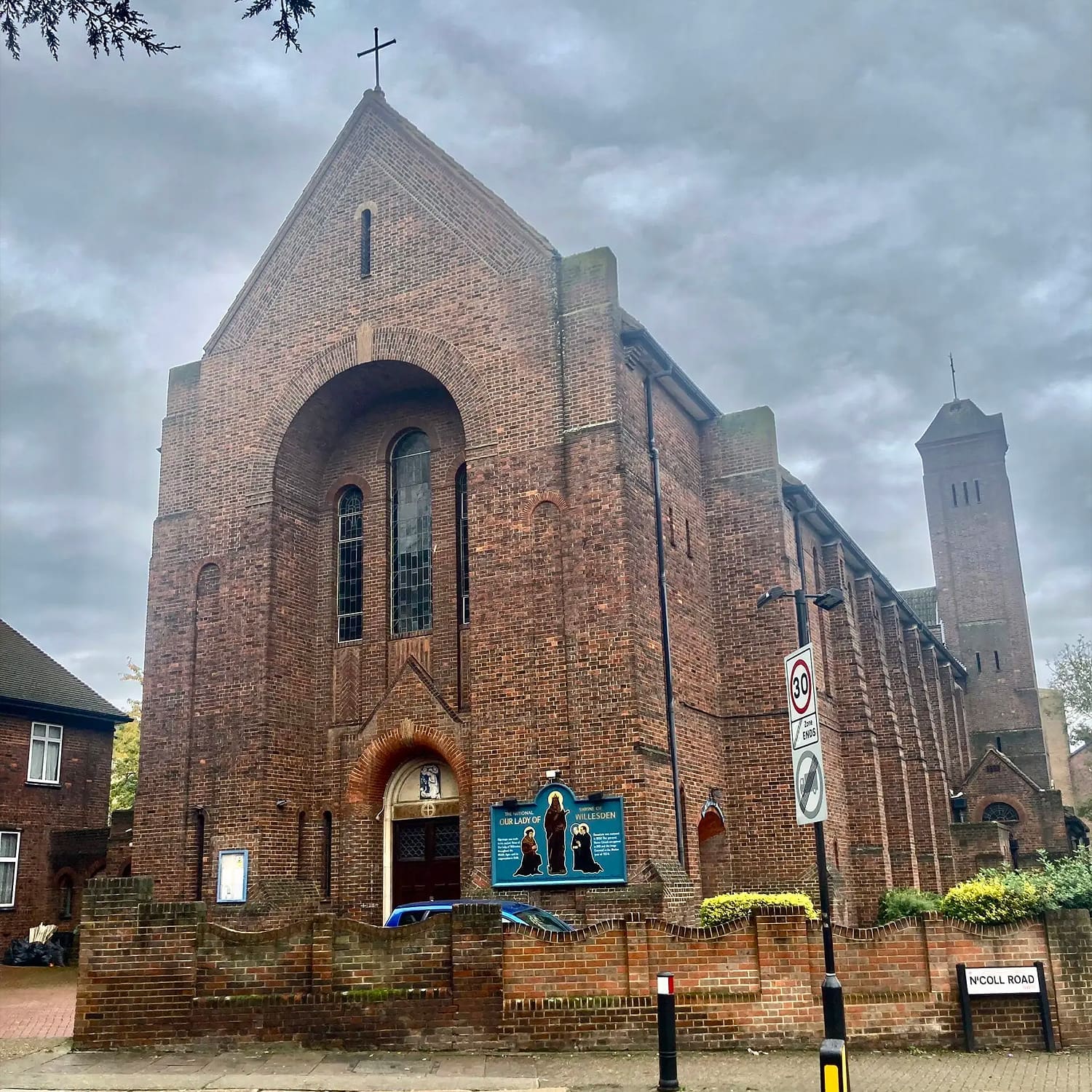

I stepped inside this church on a packed Sunday. There was a Virgin of the Passion on display (of course) and a statue of Our Lady of Aparecida to honour the Brazilians in the parish. But Our Lady of Willesden had the entire Lady Chapel off the north end of the church to herself. Her face was dark, as was her son’s, and his toddler hands were stretched out as if he were practicing for Calvary. Still, if the original statue was burned by the Anglicans, how to account for the statue today? It turns out this Madonna and child has an unexpected continuity with the original image. It was a speculative reconstruction carved from an oak tree near the original shrine.
In his informative book on the subject, Nicholas Schofield recounts that when this new statue was triumphantly processed through the streets by Catholics in the early twentieth century, they were taunted by Protestants who held signs that read “Protestants protest against the illegal and idolatrous processions.” The Catholics fired back. They placed a fitting Latin inscription over the shrine: Imago per nefas abducta amore filiorum reducta (Thy image, by wickedness looted, has been restored to the love of thy children). An iron grill was installed as “an extra protection against possible desecration.” As England’s Catholics gained momentum, the present statue was crowned in a pageant at Wembley Stadium in October 1954 so that, in the words of Cardinal Griffin, “jewelled crowns will replace the adornments confiscated . . . by the reformers.”
But just as Foxe’s Book of Martyrs hammed up tales of Protestants being persecuted to stoke Puritan piety, so Willesden’s tales are stoked up today to fire the devotion of Catholics. On my visit to the Catholic shrine at Willesden, I was told a different version of the story. Bothered by continued devotion to the Virgin Mary there, twentieth-century Anglicans, it turns out, were dumb enough to have sent an Irishman to chop down the tree where Mary appeared. He absconded with the wood from which the present statue was carved. All we Anglicans know how to do, it seems, is chop down sacred trees and stop up holy wells (and we can’t even get that right).
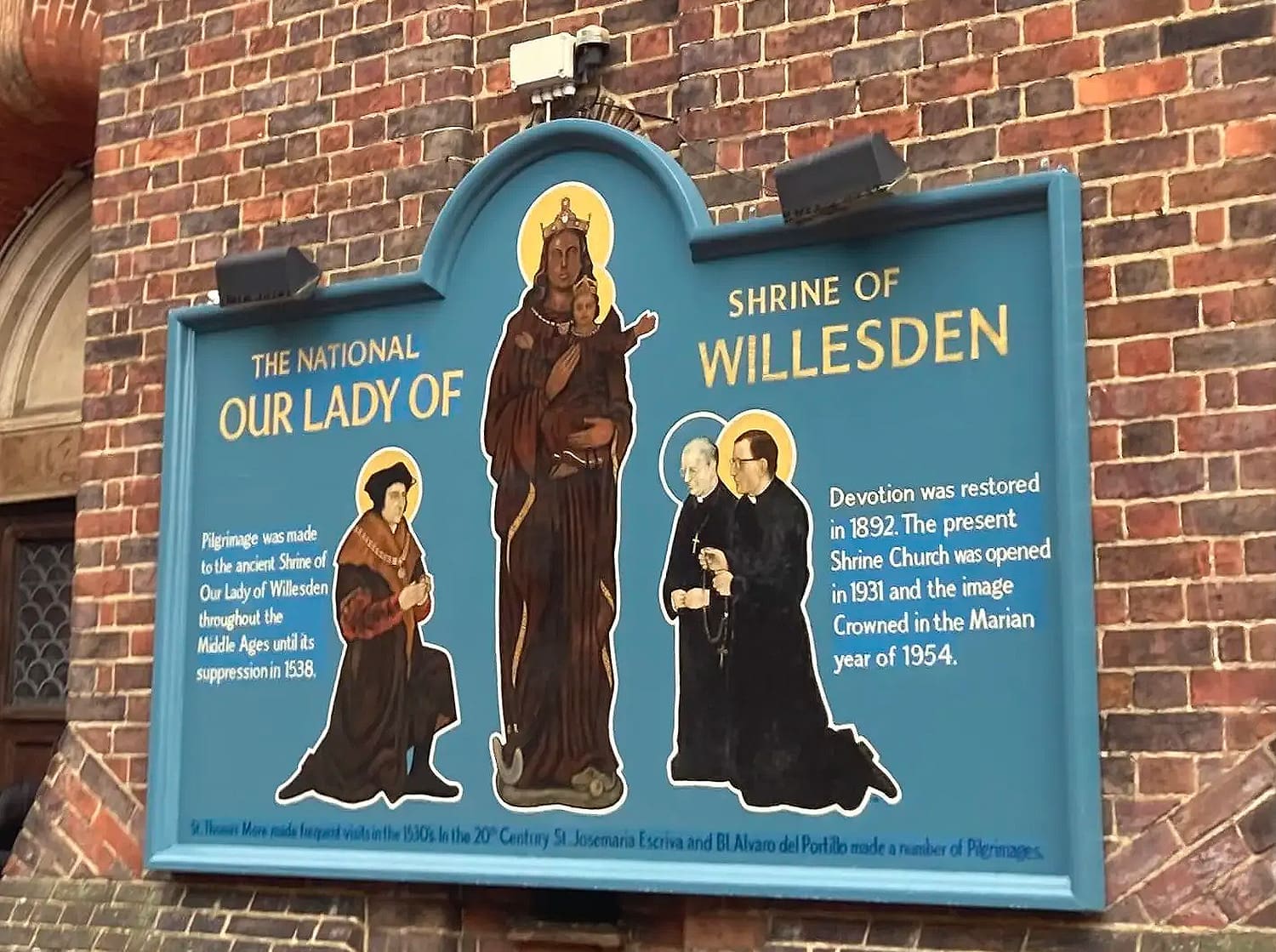

Even so, the prayer printed out at the Catholic shrine, “to pardon the crimes committed in ages past by lawless men who burnt thy images in scorn,” is being answered in a way that those who tend the Catholic shrine might not expect. For devotion to the Virgin Mary is also being revived by Anglicans. After my visit to the Catholic Willesden shrine, I learned that nearby at the original Shrine of Our Lady of Willesden, the Anglican St. Mary’s Church, one can find a newly carved Black Madonna as well. In 1911 the Anglican Rev. James Dixon, who himself had paid an “induction fine” for honouring the Virgin, restored a statue to replace the one that was burned. This was replaced by an elegantly modern statue in 1972. Even the original holy well was rediscovered in 1997, and water is available from it today. There are reports of miracles at this shrine too, such as a “golden radiance” after one particular Anglican devotee to Mary died. “I believe Our Lady Herself was there to greet her,” claimed the vicar.

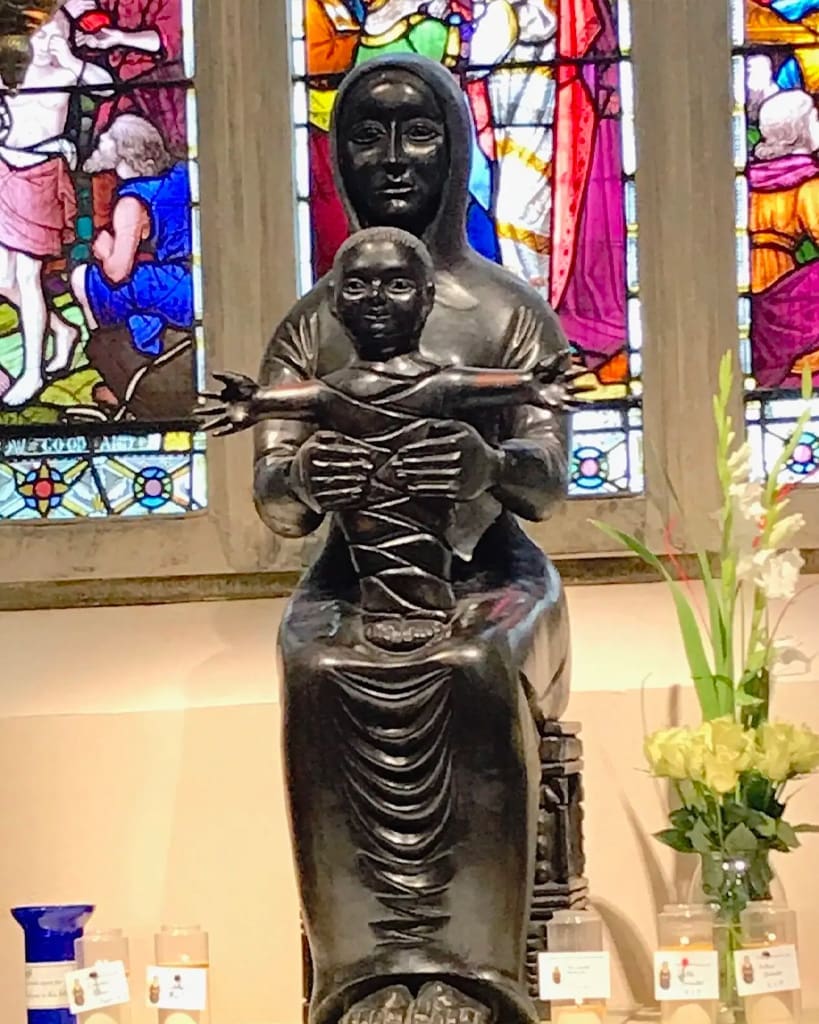
Perhaps because of this Marian convergence, when I pick up my worn and tattered copy of John Henry Newman’s justification for his own conversion to Catholicism, An Essay on the Development of Christian Doctrine (1845), I no longer find myself as unsettled as I once was. We know so much more today than the now-sainted John Henry Newman did, not because we are smarter or more eloquent (this is unlikely), but because that which is hidden has only lately been made manifest (Luke 8:17) to those of British descent like me.
“Did St. Athanasius or St. Ambrose come suddenly to life,” Newman insists, “it cannot be doubted what communion he would take to be his own.” But because of the equally exclusive claims of Eastern Orthodoxy to be the whole church, this can very much be doubted. The Lutheran theologian Ronald Rittgers describes these competing Catholic and Orthodox claims as an “impossible choice between two mothers.” Newman dismissed the entire Church of the East as but dead wood, broken “Nestorian” branches sundered from the tree of Rome; we now know this martyred church to have produced magnificent proclamations of the gospel in a Buddhist and Taoist Chinese milieu, and that they loved Mary as well. For Newman, the North African “Monophysite” tradition was also but broken branches, cut off from the true tree of Rome. But we in the present have seen these Coptic Christians martyred for their Christian faith on the beaches of Libya.
If Calvinism is destined to become Socinianism or Unitarianism, as Newman inveighs, how do we account for the trinitarian theology of Herman Bavinck or Karl Barth? It is not that there are not real heresies—there certainly are. But as David Bentley Hart puts it in his book-length critique of Newman, “Christian tradition as it is currently known, if it is a truly living unity, is as yet a unity only partly grasped, and may yet open up into a fuller unity than that arising from its own isolated history to this point. In fact, how could this not be true?”
The Anglican mystic William Law, in his seventeenth-century Letters to a Lady Inclined to Enter the Church of Rome, had a remarkably charitable answer to her concerns. “I have so much trust and confidence in the Goodness of God in the care of his church,” Law insisted, “that I hope the means of Christian salvation are fully preserved in both the English and Romish communion, for all such as are disposed to make a right use of them.” Law fully admits that there were “unreasonable quarrels and unjust claims of the governors on both sides,” such as the burning of statues of Mary. He then asks,
Can I undo what they have done, by my changing sides? Can I clear myself of schism, by being a party with one against the other, when both are to blame in what they do? . . . I stay in the church of England, because Providence has placed me in its communion, and because it has the terms of salvation; I wish everything that is schismatical in it was removed, by those who have a power of removing it; I do not go over to the church of Rome, because that would be showing my approbation of those reasons on which the governors of that church proceed in their division from others, and would make me guilty of all the wrong steps they have taken. This is not the case of those who are educated in that church.
No one who has plumbed the depths of William Law’s mystical writings could accuse him of the “liberalism” that Newman, and Newman’s teacher John Keble—a lifelong Anglican—rightly decried. I would hesitate to go so far as Evelyn Underhill in calling Newman’s conversion an act of “spiritual selfishness.” Newman’s conversion cost him dearly; the Catholic Church was then still under great suspicion in England. But Underhill may nevertheless be on to something. There are risks in conversion, risks that arise from ease, from burdens I would no longer have to face.
That, by the way, is why Mary’s face is blacker at the Anglican shrine. Because we burned her.
In effect, were I to, in Keble’s words, “dwell on fancied improvements and blessings to be obtained on possible changes of Communion,” I could absolve myself of any connection to Cromwell’s bonfire. That, by the way, is why Mary’s face is blacker at the Anglican shrine. Because we burned her. And the answer to that old destructive fire is a new living flame of love. It may be better for Marian devotion to emerge where it is least expected, within the colder hearth of Anglicanism, than in places where the fire is already lit. Perhaps this is why the Virgin and Child in the St. Stephen Chapel at York Minster is so especially beautiful: Henry VIII had replaced Mary’s head with his royal seal, but it has been lovingly restored to its original condition today. Even the All Souls Anglican Church just across from the Catholic shrine of Willesden today boasts windows and statues of Mary that testify to their love of the Mother of God.
Is not the veneration of Mary by Anglicans, who once despised the Virgin, as fitting a tribute as the material crown that bedecked the Willesden statue at Wembley Stadium? The Catholic attitude sometimes resembles a well-behaved elder sibling who is not terribly excited when a wayward younger sibling finally gets it right. (I seem to recall someone once telling a parable about that.) If the warring Huron-Wendat and Haudenosaunee can be reconciled with mutual love of the Virgin, maybe modern Protestants and Catholics can at least catch up with the level of civilization exhibited by those once called “savages,” lest the savagery be ours.
If the procession of both statues, a meeting of the Catholic and Anglican black Marys of Willesden, seems like an untenable Christmas fantasy, I am glad to report it already happened in 1980. The booklet that accompanied the procession read, “Though separate, the Shrines show the same love—to Jesus Christ and his Mother. And maybe they will help separated Christians to understand and love one another more fully.” In both statues, after all, Christ’s arms are lovingly outstretched.
I may have only made it to the Catholic Madonna of Willesden on my visit, but by visiting that one statue, I visited both, for both statues point to their prototypes, to the actual Jesus and Mary in heaven. That was the point those who burned statues were trying to make, however obtusely. Whether or not all Christians believe Mary’s physical body was assumed to heaven, all agree that Jesus’s raised body—which was born of Mary—is certainly there. And he is pleading in the Spirit to the Father for the unity of his church (John 17:21; Hebrews 7:25). Unity requires nothing less than the truth, and the truth is not always pleasant: “No tradition has been spared the desolation of division,” insists Peter Leithart. “Every Christian tradition is distorted insofar as it lacks, or refuses, the gifts that other traditions have.”
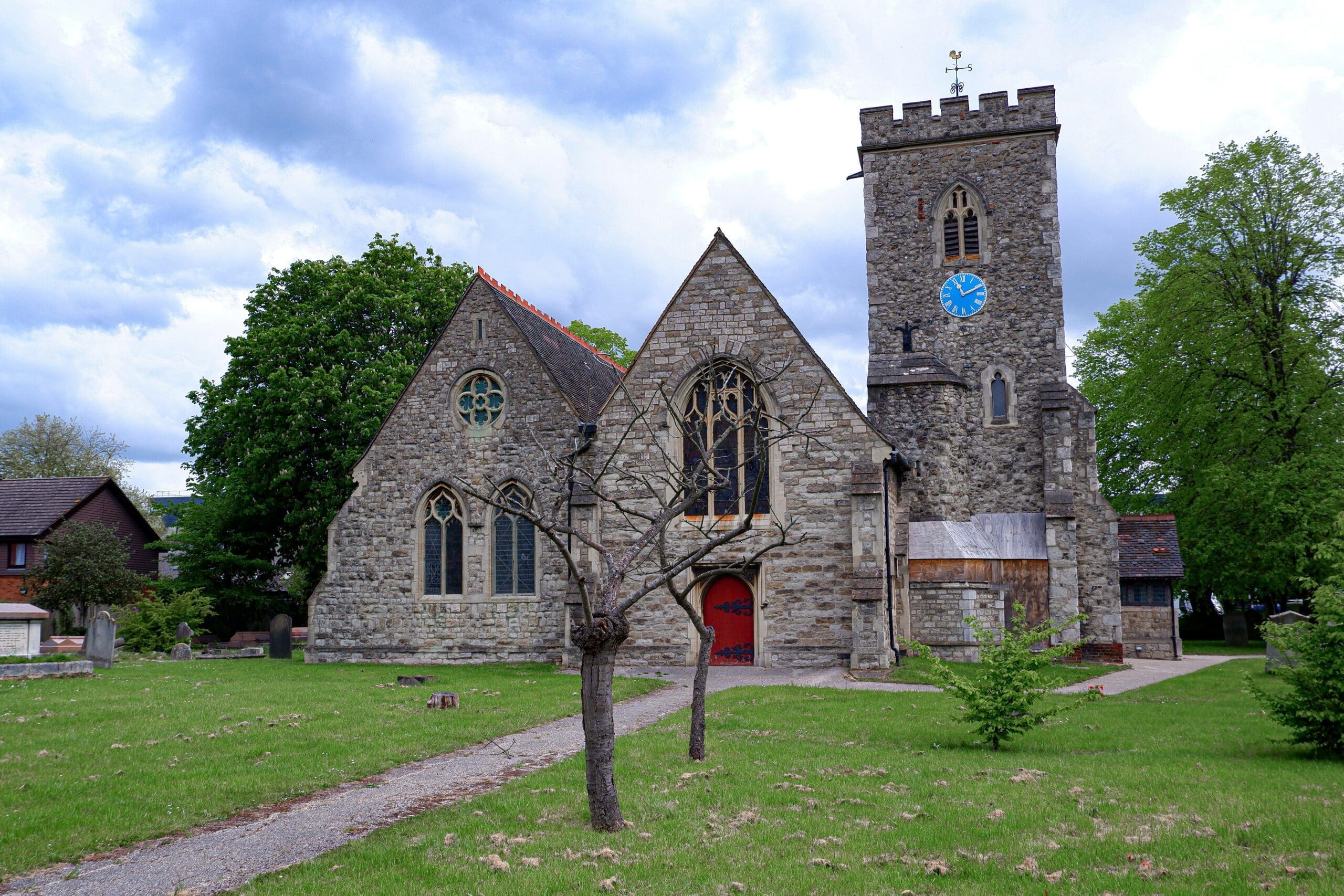
The End of the Journey
So my travels this year—from the Driftless region of Wisconsin and the street markets of Chicago, to shrines and meditation centres at Tamil Nadu in India, to Montreal and Québec City, and to London—has come to a close. My hope for those who have followed along: Even if you haven’t, like Pierre-Joseph-Marie Chaumonot or Richeldis of Faverches, attempted to replicate the Holy House yourself, I genuinely wish you a sense of the holy in your house, especially this time of year. But I offset this near sentimentality with a challenge. I cannot but end by returning to my original provocation. If you find my string of pilgrimages even remotely impressive, again: Defeat me. In the coming year, visit lesser-known shrines like Harissa, Akita, or Šiluva; or offer fresh takes on the famous ones like Lourdes, Guadalupe, and Medjugorje, and write up your journeys as well.
Christians need not choose between Christ being born in Bethlehem and Christ being born in us every morning since.
Or, better yet, let’s give up this rivalry altogether. Stay right where you are, and make your pilgrimage a secret and internal one, and pray I do the same. Let us descend into our own depths in prayer, depths that are always darker than we think. Christians need not choose between Christ being born in Bethlehem (Luke 2:7) and Christ being born in us every morning since (Galatians 4:19). Perhaps our theological and church-historical divisions, which have borne something else—a miserable witness to the world—will only be healed with a large cross-confessional dosage of contemplative prayer. This kind of prayer, born from unknowing, is as dark as the Willesden statues are black.
Ambrose of Milan puts it this way: “When the soul begins to turn to Christ, she is addressed as ‘Mary,’ that is, she receives the name of the woman who bore Christ in her womb.” Angelus Silesius raises the stakes even further: “If Christ were born a thousand times in Bethlehem, but not in you, you would remain lost forever.”
But you are not lost, and he—the Christ child himself—is there waiting for you, and for me, over and over again.
Merry Christmas, known and unknown friends.


